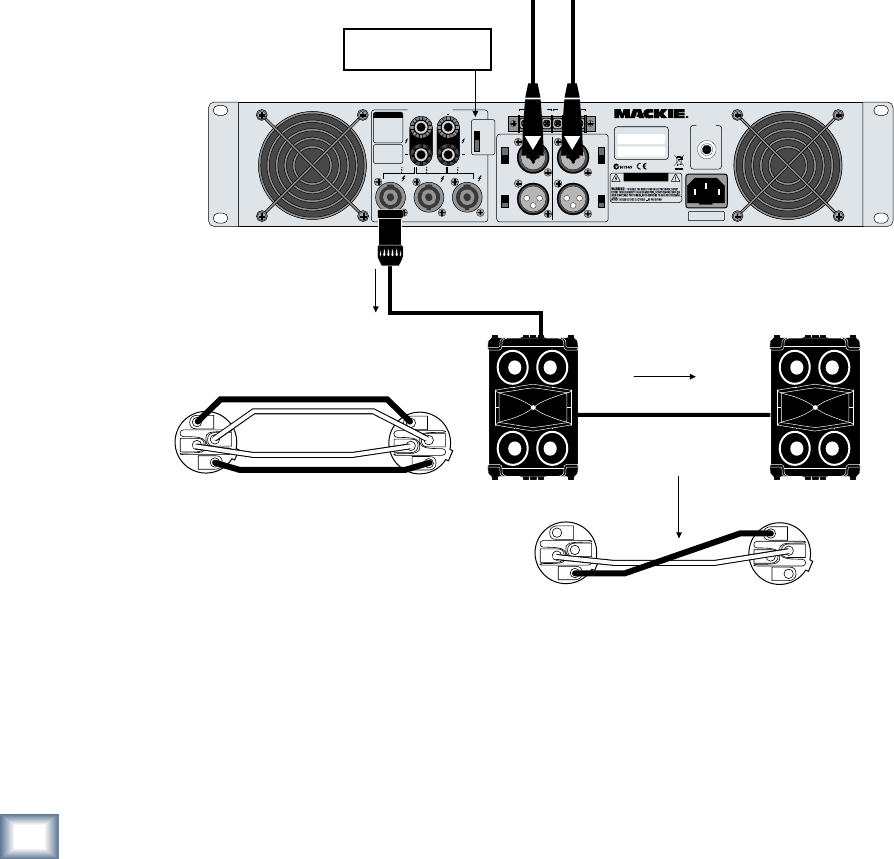
20
M-Series
M-Series
Dual-Channel Connection
The Channel 1 Speakon connector has the added
feature of providing both speaker outputs on a single
connector. This allows you to use a single cable to carry
both channels from the amplifier to the speakers. Refer
to the hookup diagram on page 7 for a typical applica-
tion using the dual-channel connection.
Many speakers with Speakon connectors provide an
Input connector and a “Thru” connector for connecting
a second speaker in parallel. You can use the Thru con-
nector on the speaker cabinet to connect the Channel 2
amplifier output to the Channel 2 speaker.
For the cable connecting the amplifier to the first
speaker, wire all four pins in the Speakon connector, as
shown below, at both ends of the cable. For the cable
connecting the “Thru” connector to the second speaker,
you need to use a “crossover” cable that connects pins
2+ and 2– on the “Thru” connector to pins 1+ and 1– on
the second speaker input end.
Stereo Dual-Channel Speakon Connection
M
.
4000
AC LINE
BREAKER
(PUSH TO RESET)
SERIAL / DATE CODE
BRIDGE
+
+ +
1 2
BRIDGE
PIN 1 = CH1
PIN 2 = CH2
PIN 1 = BRIDGE
PIN 2 = UNUSED
PIN 1 = CH2
PIN 2 = UNUSED
LETHAL
VOLTAGES
MAY APPEAR
AT OUTPUT
TERMINALS.
CLASS 3 WIRING
IS REQUIRED.
SPEAKER OUTPUTS
1
2
ON/
TYPICAL
LIMIT
OFF
STEREO
AMP
MODE
MONO
BRIDGE
CAUTION
GND
CHANNEL 1
GND
CHANNEL 2
ON/
TYPICAL
LIMIT
OFF
DESIGNED BY MACKOIDS IN WOODINVILLE, WA, USA
MANUFACTURED IN CHINA • FABRIQUE EN CHINE
©2005 LOUD TECHNOLOGIES INC. • “MACKIE” AND
THE “RUNNING MAN” FIGURE ARE REGISTERED
TRADEMARKS OF LOUD TECHNOLOGIES INC.
1300W / CH
4Ω LOAD MIN
2600W BRIDGE
8Ω LOAD MIN
~120VAC 60Hz 1600W
INPUT
INPUT
LPF
HPF
FULL
LPF
HPF
FULL
150Hz
X-OVER
150Hz
X-OVER
RISK OF ELECTRIC SHOCK • DO NOT OPEN
CAUTION
HIGH EFFICIENCY POWER AMPLIFIER
FROM MIXING CONSOLE
LEFT AND RIGHT MAIN OUT
AMP MODE SWITCH
STEREO
Passive Speakers (Mackie S408)
Crossover Cable
(Pin 2+ to Pin 1+
Pin 2– to Pin 1–)
COLD
COLD
AMPLIFIER
END
SPEAKER
END
HOT
CHANNEL 1
CHANNEL 2
1+
1–
2–
2+
1+
1–
2–
2+
COLD
FROM "THRU"
OUTPUT
TO SECOND
SPEAKER INPUT
FROM "THRU"
OUTPUT
TO SECOND
SPEAKER INPUT
TO FIRST
SPEAKER INPUT
HOT
CHANNEL 2
1+
1–
2–
2+
1+
1–
2–
2+


















